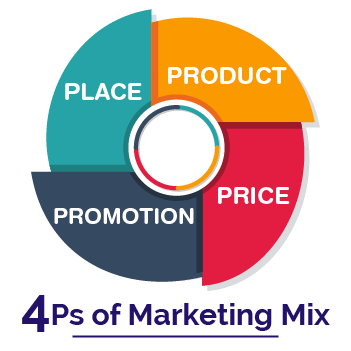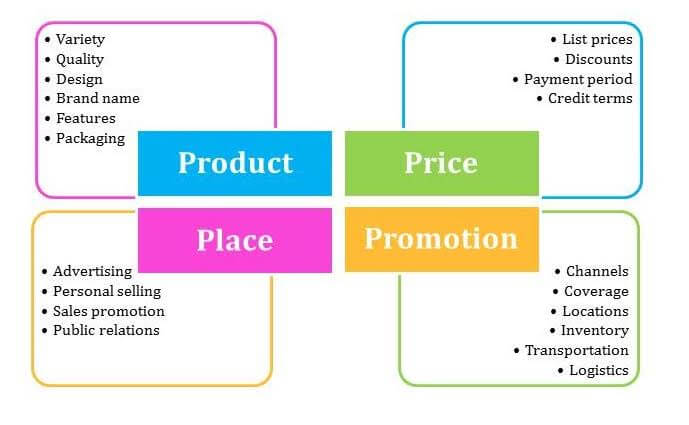The 4 Ps of Marketing and How to Use Them in Your StrategyThe 4 Ps is the primary form of marketing strategy, which comprises Product, Price, Promotion and Place. It is also known as Marketing Mix. It is not a scientifically proven theory but a conceptual marketing framework to help marketing managers make appropriate decisions. Managers use it to develop both long-term and short-term marketing strategies. 
It is a set of tools to achieve marketing objectives and spread the Product's awareness at a large scale. It is not a management theory but a simple concept-based structure for configuring consumers' needs. Currently, this strategy has been modified as per the need of the current situations of managers. The number of Ps has increased and involves People, Processes, Physical Evidence and Politics. The managers now make marketing decisions based on all such factors. History and Evolution of 4 PsBorden is claimed to be the first person to use the marketing mix and implement the framework of the marketing mix for his marketing strategies. His marketing mix strategy included 12 elements: Product planning, Pricing, Branding, Channels of distribution, Personnel selling, Advertising, Promotion, Packaging, Display, Servicing, and Physical handling, and the last one was Fact-finding and analysis. The marketing mix of Borden was complex and segregated manner. Later on, another strategist McCarthy simplified the segregated combination of the marketing mix and compressed all the 12 elements into four groups, namely, Product, Price, Promotion and Place, which came to be known as the 4 Ps of Marketing. In 1999, Goldsmith suggested increasing the number of Ps to 8 to make the marketing mix more inclusive and effective; those 8 Ps were Product, Price, Place, Promotion, Process, Participant, Physical evidence, and Personalisation. The Objective of the 4 PsThe marketing strategy is dynamic, and it varies depending upon the market, people, managers, conditions, etc., but in all the variation in marketing decision-making, the 4 Ps has been the primary structural framework. The fundamental objective of the marketing mix is to assist in marketing-related decision-making with the right combination of the 4 Ps for reaching customers and becoming their first choice. It is all done to achieve the collective aim of the company to earn maximum gain and have an advantage over its competitors. Understanding the 4 Ps1) ProductProduct is something in which a company deals; it can be any tangible goods or any services. It is the most fundamental aspect of the marketing mix because there has to be something that is to be advertised for selling. The Product is that crucial element which needs to be verified and analysed by the managers to determine whether it is satisfying its consumers or not and what could be possible changes required to be processed to make it entirely satisfactory. Products are the goods and services the business offers to fulfil customers' demands. For marketing any product, there are some critical points that managers should be clear with, like:
2) PriceIn the marketing mix, price plays a very prominent role because the consumers have to pay the price for the Product, so it should be within their range. Price is not something that should be consistently low or high, but the perfect price justifies the value of that Product. Suppose a consumer pays ten bucks for a typical pen; the same customer is ready to pay even 100 bucks if the pen is from a branded company. The difference is that the consumer understands both products' value and price relation, even though they both will perform the same task. The things that should be considered for the pricing of any product are-
3) PlaceAnother element of the marketing mix is the Place. It refers to the best way of reaching customers for selling the products with maximum possible profit. It could be through retail stores, e-commerce, specialised stores, etc. The main objective behind this element is to make the Product available to the customers efficiently and with physical evidence. Things that are needed to keep in mind are-
4) PromotionThe last P among the 4 Ps is promotion. Promotion is another marketing mix aspect involving all communication channels and methods to communicate information about the Product to all potential customers. There are some questions that the marketing manager is required to consider related to the Promotion element of the marketing mix. They are-
The promotional marketing mix consists of several sub-elements, such as-
The marketing mix promotion element aims to deliver helpful information for attracting the target customers. Through promotion, the manager tries to fulfil the following objectives-

External Behavioral factors affecting the Marketing MixExternal Behavioural factors play a significant role in affecting marketing strategies whose occurrence and effects are difficult to control by respective managers. Marketing mix also bears some of the market forces that must be considered while implementing the marketing mix concept. They are: A) Customer's Purchasing BehaviorsThe buying behaviour of consumers is determined by the following:
B) The Trade's Behavior PatternsThe behaviour of traders of the goods is depended on the following:
C) Competitors' BehaviorsThe behaviours of the competitors are based on the following:
D) Behaviours of GovernmentThe government deliberately monitors the marketing of the Product and imposes different regulations to save the customers from getting misled, like:
Benefits of Marketing MixThere are mainly two significant benefits of the marketing mix, such as-
Criticism of Marketing Mix
ConclusionThe 4 Ps, or the marketing mix, aims to achieve certain companies' goals and cater to fulfil the consumers' needs. In this modern world of business, it is vital to create awareness and branding of the Product to attract and retain customers. It is a blend of marketing elements, like Product, that covers decisions regarding the Product and its required possible changes. The Price element includes decisions and actions regarding the price and variation aspect of the goods and services. The Place element considers decisions and activities related to the movement of the Product from manufacturers to its targeted consumers. The last Ps component is Promotion, which covers decisions and actions regarding disseminating necessary information about the Product to influence the customers' buying behaviour. Thus, the marketing mix or the 4 Ps is the basic and most effective marketing strategy tool.
Next TopicTwo-Factor Authentication (2FA)
|
 For Videos Join Our Youtube Channel: Join Now
For Videos Join Our Youtube Channel: Join Now
Feedback
- Send your Feedback to [email protected]
Help Others, Please Share









